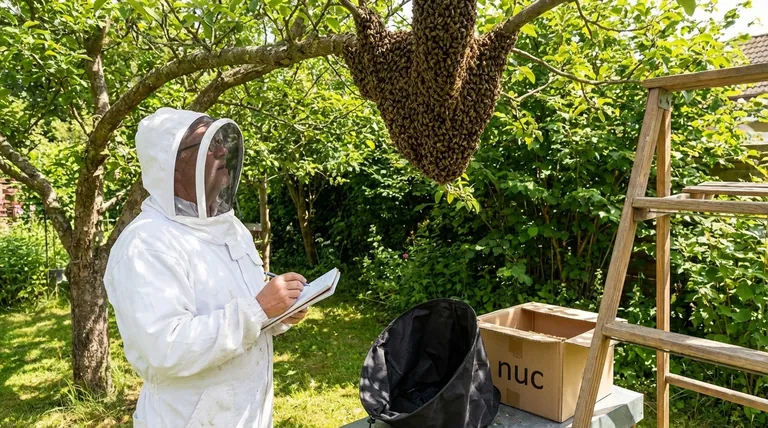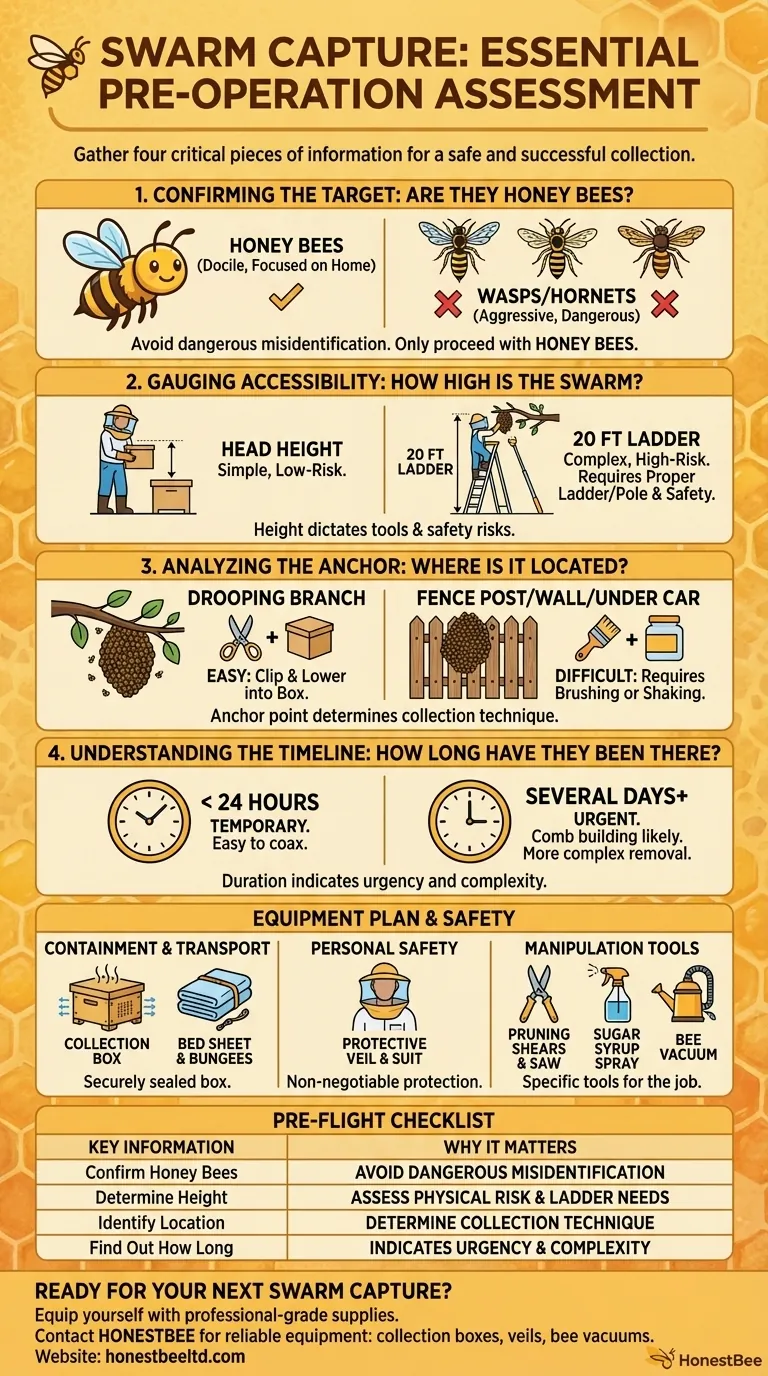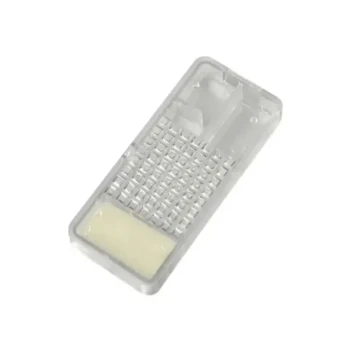Before attempting to capture a bee swarm, you must gather four critical pieces of information. You need to confirm they are honey bees, determine the height and location of the cluster, and find out how long they have been there. This initial assessment dictates the tools, techniques, and safety precautions required for a successful and safe collection.
The goal of gathering information is not just to create a checklist, but to build a complete operational picture. A successful swarm capture depends entirely on your ability to assess the situation for safety, accessibility, and urgency before you ever approach the bees.

The Four Pillars of Swarm Assessment
A systematic approach to gathering information ensures you arrive prepared for the specific scenario you will face. Each piece of data informs the next, building a clear plan of action.
Confirming the Target: Are They Honey Bees?
This is the most critical first step. Honey bee swarms are typically docile, focused only on finding a new home.
In contrast, wasps, yellow jackets, or hornets can be highly aggressive and are not the insects you are trying to capture. Misidentification is the most common and dangerous mistake.
Gauging Accessibility: How High Is the Swarm?
The vertical location of the swarm directly impacts the tools and risk involved.
A swarm at head height is simple and low-risk. A swarm 20 feet up a tree requires a tall, stable ladder or an extension pole, significantly increasing the complexity and potential danger of the operation.
Analyzing the Anchor: Where Is It Located?
You must know what the swarm is attached to. This determines the primary collection technique.
A swarm clustered on a drooping tree branch is often the easiest to collect; the branch can simply be clipped and lowered into a box.
However, a swarm on a fence post, a wall, or underneath a car cannot be cut. This requires physically brushing or shaking the bees into a container, which can be a more delicate and involved process.
Understanding the Timeline: How Long Have They Been There?
The duration of the swarm's presence indicates their level of commitment to the location.
A swarm that arrived within the last 24 hours is still in a temporary state and is usually easy to coax into a box.
If they have been there for several days, they may have started building comb. This makes the removal more complex and urgent, as you must collect both the bees and their new comb.
Translating Information into an Equipment Plan
Your assessment directly informs your equipment checklist. Arriving with the right tools is the difference between a smooth capture and a failed attempt.
For Containment and Transport
Your primary tool is a collection box, like a cardboard box or a dedicated "nuc" box. Ensure it has ventilation but can be securely sealed.
An old bed sheet and bungee cords are essential for sealing the box once the bees are inside, preventing any escapees during transport.
For Personal Safety
Always wear protective clothing. At a minimum, a beekeeping veil is non-negotiable to protect your face and neck.
For Manipulation and Collection
Bring pruning shears and a saw for swarms on removable branches.
A spray bottle with 1:1 sugar syrup is invaluable. A light mist helps calm the bees and encourages them to cluster together, making them easier to handle.
For difficult extractions from walls or other structures, a specialized bee vacuum may be required.
Understanding the Inherent Risks
Capturing a swarm is rewarding, but it is not without risks that must be managed through proper preparation.
The Danger of Misidentification
Never proceed if you are not 100% certain you are dealing with honey bees. Attempting to "capture" a large nest of aggressive yellow jackets or hornets can result in serious injury.
The Hazard of Working at Height
The most significant physical danger comes from working on a ladder. Managing your balance while handling a potentially heavy box full of bees requires extreme caution. Never over-extend your reach.
The Responsibility of Capture
Catching a swarm means you are now responsible for their well-being. You must have a hive ready for them and be prepared to care for your new colony. This is not just a removal service; it is an adoption.
A Pre-Flight Checklist for Swarm Capture
Use your intelligence gathering to make a final go/no-go decision.
- If you cannot confirm they are honey bees: Do not proceed. Advise the property owner to contact a pest control professional.
- If the swarm is at a dangerous height: Ensure you have the proper safety equipment and experience for ladder work, or call a more experienced beekeeper for assistance.
- If the swarm is not on a simple branch: Be prepared for a more hands-on collection that may involve brushing, scooping, or a bee vacuum.
- If the swarm has been in place for several days: Act with urgency and be prepared to handle delicate beeswax comb during the collection.
Thorough preparation is the foundation of every safe and successful swarm capture.
Summary Table:
| Key Information to Gather | Why It Matters |
|---|---|
| Confirm Honey Bees | Avoids dangerous misidentification with aggressive wasps or hornets. |
| Determine Height | Dictates the need for ladders or poles and assesses physical risk. |
| Identify Location/Anchor | Determines the collection technique (e.g., clipping a branch vs. brushing). |
| Find Out How Long | Indicates urgency and complexity (e.g., if comb building has started). |
Ready for Your Next Swarm Capture?
Ensure you have the right gear for a safe and successful operation. HONESTBEE supplies professional-grade beekeeping supplies and equipment—from durable collection boxes and protective veils to essential tools like bee vacuums—to commercial apiaries and beekeeping equipment distributors through our wholesale-focused operations.
Contact HONESTBEE today to equip yourself with reliable, professional equipment for your beekeeping needs.
Visual Guide

Related Products
- HONESTBEE Collapsible Tiered Bee Swarm Catcher for Beekeeping
- Twin Queen Styrofoam Honey Bee Nucs Mating and Breeding Box
- Portable Bee Mating Hive Boxes Mini Mating Nucs 8 Frames for Queen Rearing
- Plastic Transporting Bee Packages and Nuc Boxes for Beekeeping
- Styrofoam Mini Mating Nuc Box with Frames Feeder Styrofoam Bee Hives 3 Frame Nuc Box
People Also Ask
- What steps should be taken when approaching a swarm localized around many branches? A Guide to Safe and Efficient Capture
- How to attract bees to a hive box? Proven Methods for Swarm Capture & Colony Expansion
- What do beekeepers use to attract bees? Master Swarm Capture & Hive Management
- How to attract bees to a bee box? Create an Irresistible Home for Honey Bee Swarms
- What is the typical method for moving a swarm of bees? Capture the Queen for a Safe & Easy Transfer



















